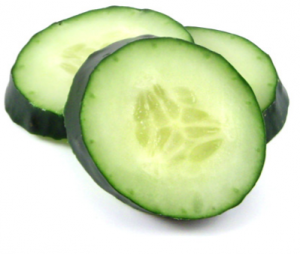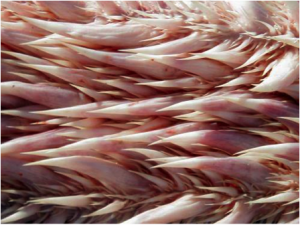
The following post is authored by Caroline Schanche as part of the Sizing Ocean Giants project. This post originally occurred on the Story of Size.
Would you convert to a diet of cucumber? Could you do what the leatherbacks have done?
None of us can really imagine surviving solely on foods such as cucumber or celery. They are about 95% water, and come in at about 8 calories per 50 grams. In order for an adult to consume the recommended 2,500 calories a day on a diet based solely on cucumber, they would have to consume 15.625kg of it every single day. Yummy. Considering a cucumber weighs around one kilo, you would have to consume almost 16 cucumbers a day, and nothing else. Seems like a lot of work doesn’t it? Well the leatherback sea turtle, Dermochelys coriacea, is the largest living sea turtle and gets to its massive size on a similar diet composed of a mainly water-based organism: jellyfish.
Although we consider eating mainly water-based foods as the road to losing weight, eating jellies is what makes these gorgeous giants able to obtain their impressive size. Starting off as tiny hatchlings at about 3 inches, they must then gain enough energy and nutrients from these jellies to grow to be on average 4-6 feet, as well as to support their high energy demands as a highly migratory species. Leatherbacks are actually record holders in migration, as they travel over 10,000 miles a year. How can they have enough energy to support this migration when all they eat is jellyfish? If I don’t get my carbs and protein I get very grumpy very fast, and I would certainly not be in the mood to cross the Pacific Ocean.

Jellyfish are mainly made up of water with a few proteins and some minerals, but not much else other than those nasty nematocysts (stinging cells). Still, the largest leatherback ever recorded weighed around 916kg. How do these giants eat enough jellies to grow to such incredible sizes? Their secret lies in their esophagus.

Our friend the leatherback has an awesome esophagus for two reasons (never thought I would refer to an esophagus as awesome, but I give credit where credit is due). The first is that it is unusually long. The esophagus of a leatherback is not a straight tube directly to their stomach as ours is, but rather it keeps going past the stomach all the way to the rear of the turtle before looping back up to connect to the stomach which still lies closer to the front. This long tube provides extra storage for jellies before they even reach the stomach, and so there is a continual supply of food being pushed into the stomach for digestion. Sort of like a storage conveyor belt of food.
The best part about having jellyfish as your main prey is that they are not very difficult to catch. All the leatherbacks really need to do is find the jellyfish to feed on them, as they will never evade an attack due to their slow nature. Lion’s mane jellies are found in big groups in Canadian waters in the summer months, so finding them is not an issue. This, plus their conveyor belt-like esophagus ensures the leatherbacks are able to pack in around 73% of their own body weight, which is several times more than they actually need to survive, according to one study (Heaslip 2012).
However, wouldn’t you think there would be some issues in eating jellyfish in general? Some people do make dishes containing this mushy creature, but I plan to hold off for now. The second adaptation of the Leatherbacks’ esophagus is aimed at helping them hold onto the jellies, as well as to protect them from their stinging juices. This adaptation takes the form of esophageal papillae, which are prongs made of cartilage that line the mouth, throat and entire esophagus of the turtle. These papillae hold the jellyfish in while the sea turtles expels salt water from its throat, as well as making sure the nematocysts do not harm the turtle. Pretty cool stuff.
WARNING: If you want to maintain your image of sea turtles as the cute and cuddly, peaceful and graceful creatures we all know and love, you may want to scroll through these pictures with your eyes closed, as their papillae tend to make the leatherbacks mouth look a little like the mouth of the Kraken. Stuff of nightmares right here:


When I first saw this picture, it left me kind of like this:
And a little like this:
Overall, Leatherback sea turtles have figured out some very interesting ways of obtaining and maintaining their massive size on a diet of a mainly water-based organism. However, its particular diet is also part of why this critically endangered animal is in serious trouble. Trash in our oceans has become a huge problem, and floating plastic bags that resemble jellyfish can be a real threat to this impressive creature. Thankfully, several organizations have started campaigns about ocean trash; one specifically about plastic bags has gone viral (pictured below from medasset.org), and I encourage you to check out their organization and the important work they are doing to preserve this amazing species.

Hopefully the future of this gentle (but sometimes scary-looking) giant takes a positive turn and we get to keep the Leatherbacks around for a little (a lot) longer.
Heaslip, S.G., Iverson, S.J., Bowen, W.D., & James, M.C. 2012. Jellyfish Support High Energy
Intake of Leatherback Sea Turtles (Dermochelys coriacea): Video Evidence from Animal-Borne Cameras.PLoS ONE 7(3): e33259. doi:10.1371/journal.pone.0033259
Ruckdeschel, C., & Shoop, C.R. 2006. Sea Turtles of the Atlantic and Gulf Coasts of the United States. Species accounts: Leatherback (pp35-51).Athens, Georgia: University of Georgia Press.
http://www.seeturtles.org/1895/sea-turtle-migration.html








As a new graduate student one of my first tasks was to help dissect a large (780lb) leatherback sea turtle (1989). I did not know of the papilae and wanted ” to see if there was anything in their mouth/throat” and shoved my hand in – only to learn about the papilae the hard way. Luckily no infection and no serious damage (except to pride).